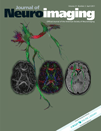Employing Symmetry Features for Automatic Misalignment Correction in Neuroimages
J Neuroimaging 2011;21:e15-e33.
ABSTRACT
A novel method to automatically compute the symmetry plane and to correct the 3D orientation of neuro-images is presented. In acquisition of neuroimaging scans, the lack of perfect alignment of a patient's head makes it challenging to evaluate brain images. By deploying a shape-based criterion, the symmetry plane is defined as a plane that best matches external surface points on one side of the head, with their counterparts on the other side. In our method, the head volume is represented as a re-parameterized surface point cloud, where each location is parameterized by its elevation (latitude), azimuth (longitude), and radius. The search for the best matching surfaces is implemented in a multi-resolution paradigm, and the computation time is significantly decreased. The algorithm was quantitatively evaluated using in both simulated data and in real T1, T2, Flair magnetic resonance patient images. This algorithm is found to be fast (<10s per MR volume), robust and accurate (<.6 degree of Mean Angular Error), invariant to the acquisition noise, slice thickness, bias field, and pathological asymmetries.




